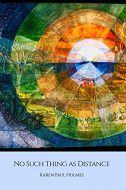 Karen Paul Holmes
Karen Paul Holmes
No Such Thing as Distance
Terrapin Books
Reviewer: David E. Poston
Reading No Such Thing as Distance, the new collection from Karen Paul Holmes, I was reminded of hearing poet Cecily Parks talk about how poems need to be generous. No Such Thing as Distance offers readers a rich family history, including favorite family recipes in the back. Much of this collection reads like a memoir in verse. Each section weaves together themes and topics recursively: the poet speaker’s own life, the illness and death of her mother, memories of her father, and observations of and meditations on the natural world from Michigan to Australia to the Nantahala forest. These poems are generous with their vivid recollections, unflinching self-examination, and the poet’s rendering of the joy found in music and the natural world.
For example, “Macedonian Wedding, Flint Michigan” tells how the narrator’s father fended off the young men lined up at church vecherinkas until she met
…a guy with an MBA who could pass
as one of us—olive skin, wavy black hair,
a taste for piroshky, baklava, and our music.
The poem describes their marriage in front of the painted iconostasis at St. Nicholas with bride and groom circling the altar three times, wearing their crowns, and the bride later leading the dance “dressed in virginal white, whirling Auntie Vera’s lace hanky.” As Boris and the Blue Tones performed,
Two hundred holding hands circled the hall
that doubled as a basketball court.
Step step step to the right, kick kick. A walking pace,
then growing more and more furious, the footwork fancy.
The drunker the older men, the lower they squatted.
thrusting feet, jumping, spinning—red-faced dervishes
(aortas about to burst), the band urging,
surging to a tornado pace.
The poems about her mother’s illness and death show a daughter moving through the stages of grief to find peace, affirmation, and even humor. “They Say We Are Not the Body” concludes with the speaker watching her mother asleep in a hospice bed, imagining
…she was already
in the green room, stepping
into a turquoise dress,
fluffing her hair,
blotting her new lipstick,
Fire Engine Red.
“Death Prefers Blonds” finds the humor in “a wig mix-up at the funeral home” and ends on a note of faith, the image of the speaker’s mother joining the family in “prayers carried on wisps of frankincense / past the gold dome of St. Nicholas.” In “Counterbalance,” the speaker reflects on how she cared for her mother without shirking, whether it was changing a colostomy bag or a dressing or laughing when a marijuana pill gave her mother the munchies. It ends by describing the moment the speaker knew her mother reconciled herself to death:
Then, it was knowing she had checked off her final item
when my brother arrived, recovered from his own cancer,
and she woke for a last moment to say his name, Philip.
In “War Bride,” she addresses her mother directly, recalling how as a child she had never considered the bravery it must have taken for her mother to leave Australia for America as a newlywed. The poem ends with daughter and dying mother watching a home movie: her mother bouncing and laughing on a trampoline with her knees bent, like an origami crane. That image of her mother becomes the way she will be remembered.
One of the best gifts is her family history: how an immigrant from Macedonia took home that war bride from Australia after the Second World War. “To My Father: Man with Three Names” recounts how her father’s name was changed first by the Greeks who took his village in Macedonia, then again at Ellis Island in 1927, but then back to his birth name at his burial. “Matilda Waltzing” traces the arc of her mother’s full and fruitful life from New South Wales in 1943 to Michigan and Florida. Yet its ending is bittersweet, describing how she
…longs for what buried Down Under,
still sees her father standing below the gangway,
his hat filling with rain.
“The True Nature of Things” is very representative of the collection. It addresses the geography of Michigan and Georgia and tells more family history, then moves seamlessly from the autobiographical to the symbolic. Wisteria in this poem is an archetypal image for whatever seems beautiful at first, before its
Tendrils slither underground,
stab up anywhere,
devil-wrap all in their path.
Other poems, though, celebrate how the heart-shaped leaves of Bradford pears, the fullness of Atlanta crepe myrtles and Traverse City cherry trees, and the beauty of lilacs never fail to lift the spirit. “Leaving Brasstown” uses the third-person point of view to describe a traveler in the night fixating on the void beyond her headlights:
a blue shiver travels her spine.
Then Beethoven heartens her,
Seek him beyond the starry canopy!
She hits the pedal and drives on,
belting it out like the last soprano.
She states in the final poem of the book, “Crossing the International Date Line,” that “…I lived this day once/and then I lived it again,” and what is literally true in that poem is emblematic of the whole collection. In No Such Thing as Distance, Holmes relives a family history of sharing meals and 6-ounce Cokes brought home from Angelo’s Coney Island; and she shares a personal history from Mary Janes, Barbie, and a crush on George Harrison to divorce and loss and the beginning of new relationships. Though Holmes writes in her prose poem “How I Would Change the Endings of Perfect Tragedies” that the real world has all the drama she can stand, she still returns to Romeo and Juliet and Rigoletto for their catharsis and world-ordering reassurances, concluding the poem with an image from the original tragedy in the Western tradition (“an apple fresh from the tree”). In the final stanza of “What do you save?” – a poem about her home being threatened by wildfire – she notes:
There’s an odd beauty I don’t want to like—
the smell of campfire, the silver-ringed sun, striated
purple sunsets. I’m in a Turner painting, everything blurred,
obscured under goose down.
Last night the moon glowed red.
As I complete this review, with August turned into September, the ginkgo tree outside my window still wears its green leaves. “Turn your eyes from the ring of gold / under the ginkgo in late fall,” Holmes advises at the end of “Warning: Don’t Cry and Drive.” But she doesn’t really mean it. The best poems here show signs that the poet was surprised by where her own creative process took her. Though they describe painful moments, they also share such joys as ballet and Brahms, Catcher in the Rye under a girl’s pillow, sunset on Lake Chatuge, and five siblings making zelnik together.

